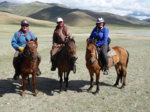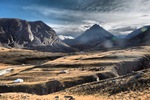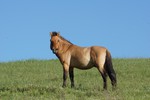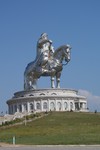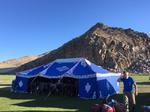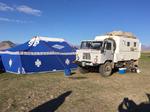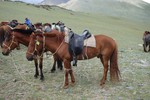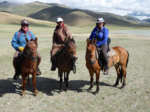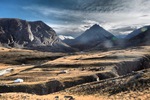
MONGOLIA BAATAR EXPEDITION 6-27 JULY 2018
Summary by John Blashford-Snell
Dawn had broken and the sun was peeping through the craggy outcrops on the hills above our camp as we set out hoping to catch sight of the world’s last wild horses.
Discovered by Russian Army Colonel Nikolai Przewalski in 1878 these stocky ancestors of the modern horse were hunted down and distributed to zoos around the world. By 1968 they were extinct in
Mongolia but by careful reintroduction from an original stock of only a dozen held in international zoos, the population now exceeds 400.
Our zoological director, Professor Terbish of the National University, reckoned we might have a glimpse of the Takhi, as they are known, watering at the Tariat stream that winds its way through
steppe and birch forests of the Hustai National Park rising to 1843m above the broad Tuul river.
We were lucky and soon saw a dozen or so of the pale coated horses browsing quietly on the hill sides. Then rounding a bend in the trail was the sight we shall not forget.
Along the meandering stream and on the slopes above it were over 50 Przewalskis. Mares with foals were being shepherded by their guardian stallion, who kept trotting back to chase off young bachelors eager to reach his harem. Others bathed in the dark waters whilst several rolled in the dust to protect themselves from ectoparasites and insects. Some groomed each other, but with much whinnying, kicking and biting a number of stallions fought as they attempted to win control of their own mares.
Parading across our front, they paid little attention to our team that could approach within fifty metres. A photographer’s paradise and a remarkable sight which few will forget.
This was in the closing stage of our expedition that had begun on 6th July with the arrival of our twenty-four international members in the rapidly growing city of Ulaan Baatar, where modern
skyscrapers tower above ancient Buddhist temples and converted Communist era apartment blocks echo to the roar of the modern traffic.
Flying some 1400 km west to the former Manchu outpost of Khovd, we made our tented camp on the banks of the fast flowing glacier fed Buyant River. It was here that the Scientific Exploration
Society’s Operation Raleigh had camped in 1992 and liaised with the local college. Now we presented the newly founded University with much needed text books.
The national festival of Naadam was in progress and battling with the infamous mosquitoes, we watched the ‘Manly Sports’ of archery, horse racing and wrestling accompanied by military parades and dancing. A truly colourful event.
However, our task area was to the South East and driving to the Baatar mountains we clambered up a steep path to the dusty Khoid Tsenkher cave that contains some remarkable palaeolithic era rock paintings, depicting cattle, ibex, argali (giant sheep) and gazelle and one illustration that looks suspiciously like a kangaroo, but is probably a camel. Directed by Mongolian archaeologist, Dr Munkhbayar, we struggled through dust clouds rising from the floor to photograph and sketch these for his research.
The next day we headed South to meet our horses in a sheltered valley that cuts into the Baatar Khairkham mountain and set up camp at around 9000 feet. Our horses began arriving in the late afternoon and straight away it was clear it was a lively herd. Judith Barker, Bridget Grande, Fran McNicol and Jane Lewis, all of whom own horses in Britain, acted as ‘Horse Mistresses’ to select mounts suited to the skills and experience of our riders. To our intense relief the old Russian Army lorry that serves as our mobile kitchen reached the valley albeit with some difficulty but our cook and her team soon had dinner ready.
From here mounted groups were deployed to locate and survey bronze age burials, study the wide range of plants and seek birds and mammals. Our old friend, zoologist, Munkhnest, put out the camera traps on the ridge above the camp and an intrepid botanical trio even managed to reach the snow fields and glaciers at around 13000 feet.
Our strong willed ponies were not all easy to control and an early casualty, fortunately not serious, was our Mongolian botanist, Dr Darikhand, who was hurled off by a ‘bucking bronco’.
Dr Tsetsegmaa, a dentist from Khovd, had joined us and was soon hard at work extracting the local people’s rotten teeth. Children received dolls and puppets as a reward after losing a tooth and were encouraged to protect the wildlife.
Our doctors also ran a simple clinic and we distributed reading glasses, donated in Britain.
A nearby ger or yurt sported a solar powered TV and a dish aerial which enabled some of our enthusiastic football followers to watch the final of the World Cup in Russia. We even found a place a few
kilometres away where our mobile phones could receive a signal, enabling us to send emails and photos home.
Around all our camps the camera traps recorded the wildlife and we also used a couple of drones for photography. Some traps revealed wildlife but others just showed curious goat herders!
On 16th July we rode south west carrying out more scientific quests. A 30km ride took us through a storm to camp by a shallow lake. Indeed, the weather varied with periods of hot sunshine to short lived squalls bringing drenching rain and biting cold winds.
At the scattered village of Bayanzurkh a health post served as a base for our medical team to hold a well attended clinic. Once again, the dentist was especially busy although a few of the men took some persuading before they’d submit to her treatment!
Here, we sketched ancient stone memorials known as deer stones which were quite remarkable and John Leach did useful dowsing surveys.
Our frisky mounts and their helpful owners left us at this point and on 19th July gale force winds struck our camp, fortunately after our mounted teams had returned. Free at last, our horses led the herdsmen a real dance as they were being rounded up for their return to home pastures.
As the weather calmed, the sky cleared and being at an altitude of nearly 8000 feet we endured a bitterly cold night. Next day the wind had dropped and we drove on to present books to a local school at Most village. Clearly these were much appreciated.
Heading east we pitched our tents on a featureless gravelly plain whose only inhabitants seemed to be the ubiquitous tubby marmots. However, survey teams in four wheel drives and Russian minibuses were despatched in all directions seeking the endangered snub-nosed Saiga Antelope. At one time this species numbered in millions but today less than 4000 are thought to exist in Mongolia.
Working with our energetic zoologist, Munkhnest, Paul Lodge’s team made the first sighting, spotting a small herd in a valley leading into some hills. Other teams caught glimpses of larger groups
racing away in the distance but the following morning, over a hundred were located. Reports and photos were provided for Prof Terbish and the Mongolian Department of the World Wildlife Fund, who are
seeking to conserve the species.
Back in Khovd on 21st July we bid farewell to most of our Mongolian helpers including the enthusiastic botanist Dr Darikhand, the dentist Dr Tsetsegmaa, archaeologist Dr Munkhbayer, as well as our
interpreters, drivers and hardworking cooks who had fed us so well.
A morning’s shopping in the local market enabled many members to invest in traditional Mongolian national dress, including the elegant, three-quarter length gown known as the deel.
A three hour flight back to Ulaan Baatar ended with a bumpy ride in a thunderstorm, with lightening flickering around the tossing plane. Safely on the ground there was a night’s stop and a hot shower at the Bayangol Hotel before we headed out to the Hustai Nuruu National Park to study the Przewalski horses and the abundant wildlife.
Apart from the numerous marmots, voles, bats, ground squirrels, hare, tiny rabbit-like pika, Siberian jerboa and numerous raptors, including Golden Eagle, we counted up to 80 Red Maral Deer. Earlier, one night patrol thought they had spotted a wolf.
Over the whole expedition we had counted and recorded 59 types of bird, 19 species of mammal and 80 species of vertebrates.
Our camp in a flower strewn valley surrounded by rocky crags, provided an ideal setting for us to hold our usual final dinner in commemoration of the Scottish poet, Robert Burns. Stahly’s haggis brought from Scotland and a liberal quantity of J & B whisky was served together with local dishes. Traditional speeches, some reeling and singing with our Mongolian friends went on into the early hours before we returned to Ulaan Baatar. We are deeply grateful to Great Ghengis Expeditions who organised the programme and logistics and all the Mongolians who did so much to make it a success.
JBS
31 July 2018
